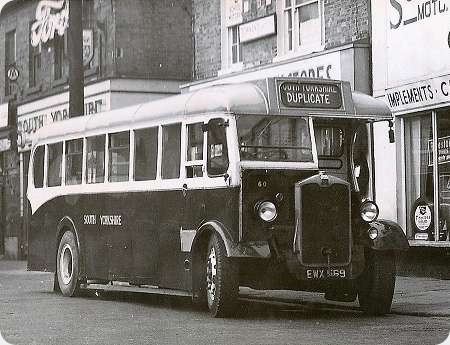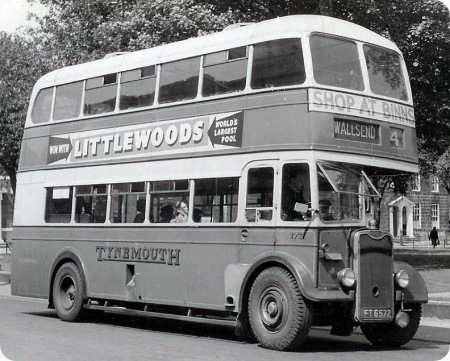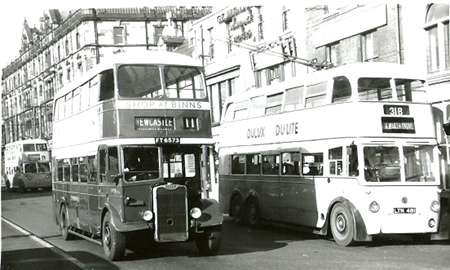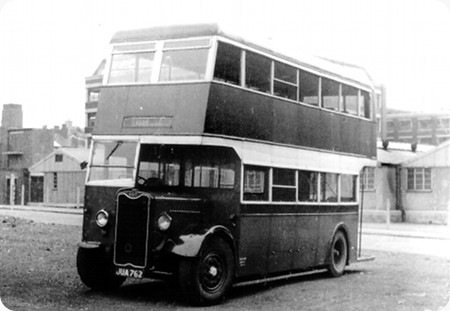
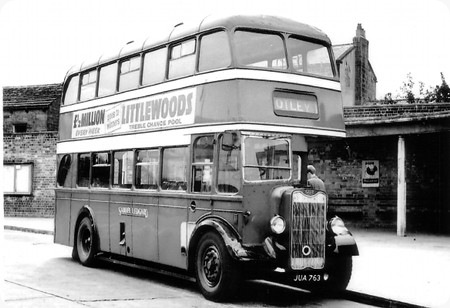
Photographs by ‘unknown’ if you took these photos please go to the copyright
page.
Samuel Ledgard
Guy Arab I
1943
Pickering H30/26R
Re-bodied 1953 Roe H31/25R
Much has been widely written about World War II utility bodywork and the appearance and durability of
the various makes. Possibly the least numerous were the bodies by Pickering of Wishaw, the uppermost
shot of one of the two Samuel Ledgard examples been shown here. JUA 762 was an Arab FD1 with the flush
bonnet and Gardner 5LW engine. It has to be said that the Pickering bodies quickly deteriorated
structurally and soon became a very sad sight. This picture clearly shows the most unusual, and
extravagant in the circumstances, upper saloon emergency exit with three large glass panes. This bus and
its FD2 twin were new in 1943 and in 1951 they were rebodied by Roe as shown in the lower view, and
initially retained their 5LW engines. In 1956 they received 6LW units which necessitated the lengthening
of the bonnet for JUA 762 - JUA 763 (lower picture) being an FD2 model was of course all ready for the
longer engine without such a modification. There were many anomalies in the allocation of vehicles by
the Ministry of Supply in those dark days and here we have a classic example - one of each model
delivered together. On the theme of utility bodies in general I have to say that I thought that the
Duple offering was of very pleasing appearance and, from my experience of working on them, possibly the
soundest and most durable in construction. The shapely Northern Counties bodies were, of course, a most
pleasing exception to the rule in their own right.
Photographs and Copy contributed by Chris Youhill
Bus tickets issued by this operator can be viewed here.
———
Go on Chris- explain about the Emergency Exit: I always take it as a door at
the upstairs back from which some unfortunate youth occasionally drops: (in my day we would not have
dared to annoy the conductor by even touching it and would ever after have to sit downstairs) was
that non-utility? Were there 3 kickout panes - presumably on each side?
I would also like
someone to tell me why these 6 cylinder Guys had to have snout extensions, sometimes if I recall
with a radiator shrouded in leather? Were Gardner engines longer than say Daimler or Leyland?
Joe
———
I don’t think Joe that there is anything dramatic about the emergency exits on
the utility Pickering bodies. Presumably it was simply their own design but seemed rather
extravagant under the Wartime shortages. The two vertical dividing pieces can just be made out in
the picture and the total glazed area is quite enormous.
I have spoken to a very knowledgeable
friend about your second question which had me foxed. Seemingly there was no excessive length in the
Gardner 6LW engines and the reason for the "snouts" is quite fascinating. The wartime
Arabs were seemingly designed with consideration being given to the Ministry orders that they were
all to be fitted with 5LW engines in the interests of fuel economy. After early deliveries it
appears that operators in hilly districts complained that performance was not adequate and therefore
the FD2 was introduced with space for the longer six cylinder unit in a few cases where "hilly
hardship" could be proved. As the chassis had been designed with transmission components
arranged to suit the shorter engine the only practicable course was to provide "the snout"
and the somewhat untidy but fascinating leather "filler." Presumably the bonnet itself
remained the same for each version, and my informant believes that a dispensation was granted as the
alteration caused the vehicle length to slightly exceed the 26 foot maximum of the time.
Chris Youhill
———
Sorry- I’ve seen it: the two glazing bars at the back. Perhaps they had three
long pieces of glass in the shed left over from a carriage contract- doors? (that’s a wild guess!).
I thought you meant those three plain windows at the rear- but then you had privileged access to the
back!
Joe
———
I wish someone would produce, like magic, a full rear view of the Pickering
bodies - nobody seems to have one - and I was really glad when this nearside view turned up quite
recently as the strange emergency door glazing can at least just be seen - I was beginning to fear
that my memories of teenage years was perhaps playing tricks on me.
Chris Youhill
———
Obviously, everyone goes for the standard 3/4 front view picture, and I have
no dispute with that. Very few people seemed to take the equally characterful rear 3/4 shots, and
even less managed to capture the interior atmosphere - the different designs of seats, light
fittings, bell-pushes, framing etc. Of course, interior shots in the pre-digital era meant extra
expense on flash, and not entirely satisfactory results because of glare from glazed surfaces and so
on. But the interior (and of course the sound) was THE bus travel experience. Any interior and/or
rear shots out there?
Stephen Ford
———
The ‘snout’ was a means of accommodating the extra length of the
six-cylinder (6LW) Gardner engine when it replaced the five-cylinder (5LW) unit. Gardners were
generally quite long engines for their capacity. This was due them having a ‘timing case’ of
generous proportions, housing a triplex timing chain, and also due to the arrangement of the
cylinder blocks. The latter were split into pairs, so a 4LW would have two 2-cylinder blocks, a 6LW
two 3-cylinder blocks and a 5LW would have a 3-cylinder plus a 2-cylinder block (no doubt today this
would be termed ‘modular construction’!). This arrangement added to engine length as the water
jacket had to extend around both ends of each block, and there was a gap between each block as well.
The original Guy Arab utility ‘decker was built to the 26ft overall length of the
period. By the time Sammie’s ‘twins’ were re-bodied, double-decker dimensions had been
increased to 27ft. Thus a more powerful, but longer 6LW could be fitted by extending the bonnet and
moving the radiator forward to accommodate it. The alternative would have been to have the rear of
engine protrude into the lower saloon, no doubt entailing modifying the front bulkhead, shortening
the prop shaft and altering the gearchange linkages. Possibly the chassis cross member behind the
engine would require attention as well. Moving things in a forward direction was much simpler!
Apparently after production of the first 500 utility Guy Arabs, the bonnets were lengthened in
order to accommodate 6LW engines, should operators require them. Special dispensation was authorised
to allow for their slightly increased overall length. These became known as Arab Mark IIs, with the
original design, unofficially I believe, becoming the MkI. As you say Chris, one of those anomalies
of the time - the two buses must have been ‘on the cusp’ in production as it were, hence an
FD1 and an FD2 delivered together. Interesting stuff!
Brendan Smith
———
Thanks indeed Brendan for those most interesting facts about Gardner engines.
While I’ve always been aware of the method of producing 4, 5, or 6 cylinder units by combining two
blocks as necessary, I certainly never suspected the extra problems of multiple cooling jackets and
intermediate gaps !! I have just looked up the records and am amazed to discover that JUA 762 and
763 were, despite the consecutive registration numbers, delivered and entered service five months
apart - and there is a gap of 69 between the two chassis numbers. This seems to suggest that there
was perhaps a "holding back" of some vehicles by The Ministry of Supply while they decided
which operators could prove the greatest need at a particular time.
Chris Youhill
———
Some of the most attractive buses which LGOC/LT had in the Thirties/Forties
were the 6-wheeler AEC Renown ‘Bluebirds’ LT Class, which were the last of the breed. The last
20, however, were fitted with Gardner 6LW engines which made the bonnets so long that the bodywork
design had to be shortened (at the back) to keep them within the legal length! It showed in the
upstairs side rear windows and the platform side opening being shorter! And they looked like pigs
with their snouts!
Chris Hebbron
———
03/06/11 - 17:12
Can anyone remember Nudd Brothers and Lockyer of Kegworth Nottm., who rebuilt
utility bodied ex London Transport Guy Arabs for Edinburgh in the early Fifties, which had a full
front but open to the near side, very smart looking buses.
Roger Broughton
———
04/06/11 - 06:43
I agree Chris H that the "Bluebirds" were magnificent looking
vehicles, and incredibly sleek and of tidy design for the early 1930s - and actually I could also
forgive the appearance of the "long bonnet" Gardner powered ones - I was once told that
they were fitted with special horns which went "oink oink", and if you’ll believe that
you’ll believe anything !!
Chris Youhill
———
04/06/11 - 06:46
Yes, the Edinburgh Nudd rebuilds were very attractive, and it wasn’t just the
side that was open: there was no glass in the nearside ‘windscreen’ either. They were in fact
halfcabs disguised as full fronts. They were built just after the company was taken over by Duple,
and based on a Duple design.
By coincidence we have just been discussing Nudd Bros & Lockyer
in another context. Click on this quick link, wait a second or two
to view.
Peter Williamson
———
05/06/11 - 14:19
As for pigs, Chris Y, I thought the only buses which oink-oink’ed were the
Dennis ‘pigs’, the pre-war Dennis Aces and Maces!
I do recall reading somewhere that the Nudd Edinburgh Guy bodies were somewhat
frail. They were designed to be lightweight, maybe they were too lightweight!
Chris Hebbron
———
05/06/11 - 14:22
When first delivered the rebuilt Edinburgh Guys had a very flamboyant
"grille: this was later replaced by Edinburgh’s own version of the Leyland BMMO inspired tin
front.
Preserved 314 JWS594 has had the original flamboyant front restored and is now resident
at the Scottish Bus Museum at Lathalmond.
Chris Hough
———
05/06/11 - 14:23
I tend to think that the Edinburgh Guy’s were the only complete bodies ever
produced by Nudd Bros & Lockyer. I believe all of their other production were re-builds.
Chris Barker
———
07/06/11 - 09:36
They were certainly attractive buses, even with the flamboyant front! See here:
Chris Hebbron
———
10/07/11 - 07:47
Pickering of Wishaw was set up in 1864, and was mainly a constructor of
railway rolling stock. It seems that only about 37 Pickering utility bodies, all of them highbridge,
were built in 1943, and no further bodies by this firm appeared during the war. They quickly became
known for shoddy workmanship, and, notwithstanding official exhortations such as "Walls have
Ears", "Be like Dad, keep Mum" and "Careless Talk costs Lives", this
appalling reputation spread throughout the bus industry. It is surely certain that this also came to
the knowledge of The Ministry of Supply, and was the reason for no further utility bodies being
sought from the Pickering company.
Roger Cox
———
11/07/11 - 07:22
That is most interesting Roger and, while I knew that there weren’t many
Pickering utilities around, I had no idea that there were as few as that - regardless of censorship
one might be forgiven for saying that there were approximately 37 too many. On the bright side,
however, their awful quality and very early demise caused the excellent Roe rebodying of the two
Ledgard examples and brought to my career one of the most delightful and characterful vehicles (JUA
763) that I ever conducted and drove. RIP "T’Guy."
Chris Youhill
———
11/07/11 - 11:18
I recently discovered that Nottingham City Transport were "blessed"
with 5 Pickering-bodied Guy Arab I’s in 1943. They were No.s 89-93 (GTV409-413?). In the published
Geoff Atkins photo the 3-piece window to the emergency door is also discernible. Nottingham’s
Utility fleet eventually had a total of 16 Arabs, the remaining 12 being Massey or Weymann, plus 27
Daimler CWA6s with Northern Counties, Brush or Duple. Apparently the first Utilities were not
withdrawn until 1956, so it seems that even the wretched Pickering bodies must have lasted at least
13 years.
Stephen Ford
———
12/07/11 - 05:40
The Pickering story is indeed an interesting one and I have done a little
research and it seems there are a few inconsistencies. In an article in Classic Bus in 1993 about
Pickering’s link with Northern General, a figure of around 65 double deck utilities is given, mostly
on Guy Arabs but also some Leyland TD7’s and some re-bodies of older chassis. Some of the Guys went
to Sunderland District and Sunderland Corporation purchased two from Blackburn Corporation in 1948
(so they had a re-sale value!) These clearly did not have the three pane upper deck emergency exit
but the Nottingham ones did.
Turning to single deckers, it is recorded that Pickering bodied
54 Albion CX13’s to MoS specification in 1946, 30 of which went to Red and White, others to Economic
of Sunderland and South Yorkshire. In fact Red and White had 22 more Albion/Pickerings in 1947 but
by this date, presumably there would have been no MoS involvement. Most but not all R & W vehicles
were re-bodied by BBW after 5 or 6 years and Ledgard’s purchase of five in 1959 were ex Pickering
re-bodies (perhaps Chris Y knows if the BBW bodies were much better?) Apparently Northern General
had around a hundred vehicles re-bodied by Pickering, on AEC and SOS chassis and the average further
life was about nine years, presumably by the end of the 1950’s they had become distinctly archaic!
There were also ten Meadows engined Guy Arab III double deckers for Tynemouth in 1949 and these were
of very pleasing appearance, they appeared to be of substantial construction and I know nothing
about them but I wonder if they went any way towards making amends for what had been produced
earlier.
Chris Barker
———
12/07/11 - 14:47
According to Alan Townsin`s book, "The Utilities" in the Best of
British Buses series, Pickering produced 18 utility bodies on Mk.1 Arabs, and 37 on Mk.2 in 1943.
There is no mention of any other bus build until the Albion contract of 1946, and I am not aware of
any Pickering bodies on CWG5 chassis.
Perhaps they were busy with other wartime contracts, as
the whole bus building business was under the strict control of the MOWT, and based on a contract
system.
I suspect that Pickering was no worse than most other utility bus builders of that
time, as most makes demonstrated severe problems with the use of unseasoned timber, and the lack of
alloy metals. I cannot comment on the 1946 Albion single deck contract, which was largely allocated
to the Scottish Bus Group, but there was certainly nothing wrong with the post war Aberdeen
streamlined trams, which exuded quality!
John Whitaker
———
13/07/11 - 07:33
Your research is interesting Chris, as I have since realised that there were
some Pickering bodies on unfrozen TD7, which would probably account for the difference between Alan
Townsin`s 55 Guys, and your total of 65. Certainly Leicester had a Pickering TD7.
I cannot
think of any rebodies at the moment, but there probably were some, but definitely none on Daimler
wartime chassis. CWG5 chassis were only bodied by Duple and Massey (High) and Brush (low).
Glasgow received several batches of post war Pickering bodies which had reasonable lives I
believe.
Regarding the triple rear window, was this a unique feature, or am I correct in
thinking that a very early Duple bodied Arab 1 for Maidstone had a similar feature? Was the triple
window even carried on after the first few bodies, or did Pickering comply with the utility
directive at that time, and panel over the whole thing?
John Whitaker
———
13/07/11 - 08:47
Re. Pickering utility bodies, I have re-read Alan Townsin’s Utility book. If I
read correctly, Pickering would not have built any utility bodies on reconditioned chassis, as
"rebodying" was also controlled by the MOWT, and firms were allocated this function,
Pickering not being one of them. East Lancs and NCB were the principle firms here, with Croft also
involved in Scotland.
The whole utility chapter is absolutely fascinating!
I personally
find as many differences in design amongst utility bodies as existed in peacetime. Beauty is in the
eye of the Beholder, and they have a fascination and charm of their own to me!
John Whitaker
———
13/07/11 - 11:57
Hanson of Huddersfield received four Pickering bodied Albion CX13’s in late
1945, 186-189 (CCX 880-3) and a further four, 196-9 (CVH 226-9) in 1946. All had been withdrawn by
1950. 186-9 were sold to Carmichael of Glenboig (a photo exists of 186 with Carmichael with the body
apparently heavily rebuilt) and 196-9 were sold to Birkenshaw Mills for staff transport, suggesting
that these bodies were perhaps considered to be too badly deteriorated for further psv use.
Incidentally, a further four Albions were taken into stock in 1947/48 two with Burlingham and
two with Duple bus bodies and these remained in service till 1958-62
Eric
———
14/07/11 - 06:33
Opinions, respected naturally, seem to vary on the quality of the Pickering
utility double deckers and I can only speak from personal experience as a youthful passenger in two
of them on Guy Arab chassis. Sadly I have to say that they very rapidly deteriorated into a sorry
state and were also I think far from handsome. While I appreciate that unseasoned timber and other
unsatisfactory materials caused problems in most makes I have to say that, again from personal
experience this time including driving and conducting, we had no significant trouble with the Duple
and Roe versions, both of which were tidy looking and attractive in their "utility" way
and many examples of ours gave very long service. Oddly the Park Royal "relaxed" vehicles
(London Transport D182 - 281) which didn’t enter service until May 1946 onwards did involve very
serious timber problems and much rebuilding was often needed. Despite this however, once
"fettled" they too gave long and extremely reliable service on arduous and busy routes and
I admired and delighted in them - their various "London" features adding to the magic - we
had twenty two out of the hundred, quite an impressive proportion I think.
Regarding the Albions, rebodied from Pickering to BBW. I had experience only
of the Ledgard five and they were splendid machines. The BBW bodies appeared sound and of course
bore a close resemblance to their attractive Lowestoft ECW cousins. The Albion chassis were a potent
delight with one of the quietest and smoothest diesel engines to be found - and the gearbox gave a
creditable impersonation of prewar Leyland TS and TD models - altogether a fascinating package
!!
Chris Youhill
———
14/07/11 - 06:36
Certainly the wartime utility bodies suffered from the use of unseasoned ash,
and materials were strictly allocated to manufacturers who had to take what they were given. Even
so, some body manufacturers had better construction standards than others, and generally did a good
job in difficult circumstances. In such worthy company, Pickering did not measure up too well.
Didn’t one municipality cancel its order for Guys when it learned that they would be bodied by
Pickering? Nowadays, railway stock design requires the entire vehicle to bear the stresses.
Traditionally, in the past, railway and tram bodies relied on substantial under frames to carry the
main loads, and rail borne vehicles are not subject to the same level of shocks and jolts as a road
vehicle. Perhaps the bus body designs of the railway orientated Pickering concern did not take such
factors sufficiently into account.
Roger Cox
———
14/07/11 - 09:51
It has to be remembered, too, that each bodybuilder, bizarrely, was able to
design its own body; thus some designs were probably structurally sounder, to start with, than
others. And I recall that at least one bodybuilder rejected some timber as being, even for those
dark times, beyond the pale! London Transport were always impressed with the Duple product, even
though they never used them in normal times. But even they gave up on overhauling the bodies as part
of their normal high standards, opting to dispose of them prematurely. Since many of them then went
to humid Far East climes, I wonder how they fared there! As for the escape upstairs rear windows,
although many of London’s Guys had them steel-sheeted over, I don’t recall any of the 181 earlier
Daimlers being so treated.
Chris Hebbron
———
14/07/11 - 18:58
I was delighted to read responses about Pickering utility bodies, and accept
that they must have been a bit on the flimsy side, but it is just that I find them, and all
utilities, absolutely fascinating!
Leicester had a Pickering TD7 which they cut down to single
deck in 1950, and it ran, although rarely, as such until 1955! (No.347) I think it is true to say,
though, that all builders in this era had their problems. The Brush CWA6 bodies in Manchester hardly
had long lives, and Park Royal trolleybus bodies were withdrawn very early in both Newcastle and
Reading. I would agree with Chris Y about Duple, as Alan Townsin also came to that conclusion too,
and who better to judge than that?! It was probably due to the wedge shaped stiffener at the front
near side canopy area.
Pickering were basically rolling stock (railway) builders, which is
probably significant, but so were Roberts, and Hurst Nelson. The latter were the third biggest
Tramcar builder in the UK, but only VERY rarely did they venture into the bus field. I believe the
panelled emergency exit was a requirement which was relaxed in early 1943.
John Whitaker
———
15/07/11 - 07:29
I believe that the municipal who cancelled their Pickering allocation was
Derby, who would have recevied two on Guy Arab I 5LW chassis. The MoWT allocation system usually
meant that body buiilders in the north had their products delivered to operators in the north, and
similarly for southern builders to southern operators. This was a general rule, I believe. So Derby
was "quite southern" for a Pickering build. But where did these two go? - all the way to
Brighton, where they entered the Brighton Hove & District fleet! Nos 6364/6365 (GNJ 574-5) lasted
there from 1943-1949. Although neighbouring Southdown has 100 Guy utilities, BH&D found this pair
non-standard. Their other utilities were Park-Royal bodied Bristol Ks. The two Guys found themselves
transferred in 1949 to Western National, where they operated out of Plymouth garage. (This is from a
memory of a photo in Buses Illustrated many years ago). I have no information as to how long they
stayed there, although WNOC did have other Guy Arab utilities delivered new, so the chassis would
have been acceptable. I have read comments elsewhere (I think in "Classic Bus" magazine)
that several builders of rail vehicles had a hard time when entering the bus building business.
Pickerings is usually quoted as the prime example, and Cravens also get a mention.
One contributor mentioned the post-war streamlined Aberdeen trams, which he
said were good products. An article in Classic Bus a while ago recorded that Aberdeen wanted English
Electric to build these trams, and placed their order. However, EEC had decided to withdraw from the
tram/bus market by then, so would not accept an order. However they had drawings of the design that
Aberdeen wanted. The Corporation then placed it’s order with Pickerings, who approached EEC for
copies of the drawings. EEC not liking this intrusion, refused the request. What to do? Aberdeen
then resubmitted their order to EEC, who then subcontracted the work to Pickerings, and sent them
the drawings for the contract!
I hope I have this right - if the Classic Bus contributor or
another reader spots an error in this, please send in a correction.
Michael Hampton
———
15/07/11 - 10:47
Yes Michael, I believe you have that right! The Aberdeen streamliners were
actually an EEC design, as shown by the 4 pre-war almost identical examples (inc. the 2 x 4
wheelers). English Electric withdrew from this business and did not re-enter after the war, so the
Aberdeen cars were built by Pickering to the pre war EEC drawings.
John Whitaker
———
15/07/11 - 10:47
Michael H Mentions Cravens in his list of bodybuilders This Sheffield based
firm built several batches of vehicles for its home town and also for others as far afield as
Portsmouth In post war years they built AECs for Sheffield and RTs for London Their latter were sold
on as non standard in the fifties but ran happily for others somewhat in the manner of DMS class
buses a decade or too later. I think although this is open to clarification Cravens became part of
John Brown engineering as did East Lancs for a time in the sixties East Lancs designed buses were
built in Sheffield under the Neepsend name in the old Cravens factory
Chris Hough
———
15/07/11 - 13:59
Yes, I recall Cravens bodied 45 AEC Regents 5 Regals for Nottingham City
Transport in 1937. It was the old story - they undercut previous suppliers Metro Cammell and
Northern Counties and got the business. Build quality was not up to scratch, and serious rebuilding
was necessary - making them actually more expensive in the long run. Two quotes come to mind :
1. "The bitterness of poor quality lives on long after the sweetness of low initial cost
has been forgotten"!
2. Reporter’s question to astronaut : "What do you think about
when you are waiting for blast-off?" Reply : "I think that every component in this
spacecraft went out to competitive tender, and the lowest price won" !
Stephen Ford
———
15/07/11 - 14:01
Strictly speaking, Cravens bought East Lancs directly - as noted in the
TPC/Venture book about East Lancs. Cravens then sold out to John Brown. The Neepsend bodies were
built in another factory at Neepsend in NE Sheffield, the original factory being in Darnall SE
Sheffield where railway rolling stock continued to be built.
The East Lancs workforce feared
for their jobs at this time but, apparently, the quality of build in Sheffield was not as good as in
Blackburn and when demand dropped in 1967/8 the Neepsend factory was closed.
David Oldfield
———
16/07/11 - 07:04
I think I would agree with John W that perhaps history has been a little hard
on Pickerings. Obviously some products would come to be known as better than others but given the
circumstances and materials of the utilities plus the fact that Pickerings were relative newcomers,
I think allowances should be made and of course operator maintenance was a big factor too, which
would explain why a quality operator such as Nottingham City Transport ran theirs for 13 years (that
is not to denigrate Ledgard in any way whatever!) I wish someone could post a picture of the
Tynemouth Guy’s of 1949 which were very fine looking vehicles!
What excuse, however, could be
made in peacetime? I think the dubious epitaph would have to go to Strachan’s who turned out a great
many sub standard vehicles over many years after 1945 which had to be heavily rebuilt or withdrawn
early, the worst of which and surely the record holders being the Leyland PD1’s supplied to Western
SMT in 1949 which fell apart after only three years!
Chris Barker
———
06/09/11 - 07:19
J Laurie`s Chieftain buses of Hamilton had 2 TD1s rebodied with Pickering
utility bodies. One had a Sheffield registration, the other had come from Western SMT. Both of these
buses had lowbridge bodies.
Central SMT had a substantial number of TS2 single deckers from
1932, originally bodied by Pickering.
Jim Hepburn
———
12/09/11 - 08:43
PS. to the last comment.
I should add that these TD1s had six bay
windows as they probably had originally. They are the only utility bodies I’ve seen with six bay
windows.
Jim Hepburn
———
13/09/11 - 07:45
Did some of the Croft utility bodies in Scotland not have 6 bay layout Jim? I
think also that Pontypridd had some BBW utility bodies also to that layout.
John Whitaker
———
13/09/11 - 07:48
Jim, the Pearson framed bodies were also of six bay utility construction. You
can see a picture of a former Crosville TD7 thus bodied on "The People’s League for the
Defence of Freedom" gallery.
Roger Cox
———
17/09/11 - 08:08
You may be right, but as I said these were the only 6 bay utilities I had come
across. The TD1s had a shorter wheel base than a TD7 so they seemed to be quite a sturdy body.
I could never take to the Duple version.
I thought the Massey highbridge body was pretty
smart.
Jim Hepburn
——— Top of this posting ———
